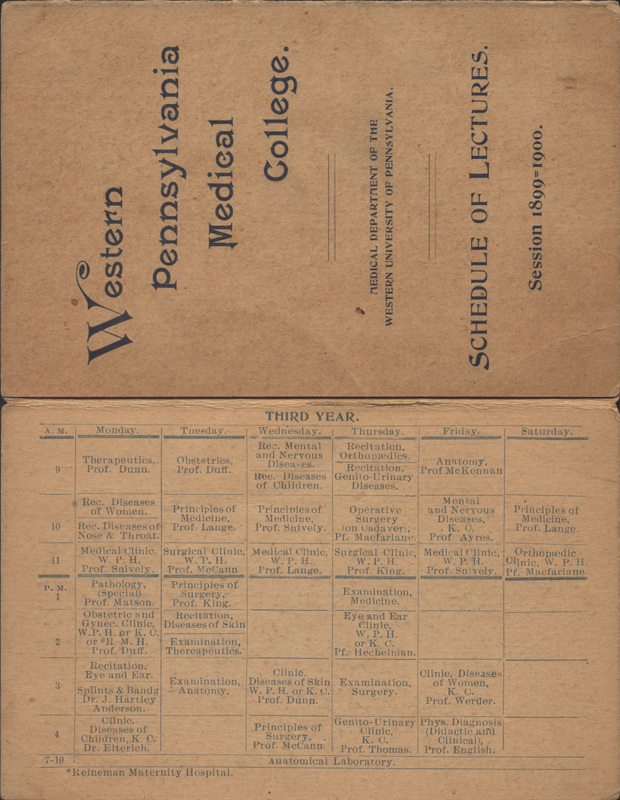Lecture Tickets
At the end of the 19th-century, the medical students in Pittsburgh would be able to acquire admission tickets to attend lectures. Before flipped classroom models and online access to the school’s offerings, the system of signing up for classes and participation in coursework was slightly different. Lecture schedules were printed for each session. The printed schedules were easily folded into a pocket size format and could be carried around for a handy reference. The participation in didactic and clinical lectures, attendance in demonstrations and laboratory work was expected. The learning and practice of diagnosis required a large portion of time devoted to clinical study and observation.
Lecture Schedules
Ticket System
Students had to purchase tickets to attend lectures and clinics. The tickets were confirmation that the fees were paid and the lab work was completed. The system of tickets embraced not only lectures and clinics, but also special quizzes and courses, and the right to register for the classes. Each ticket served as admission pass, receipt, and confirmation that the requirements were met.
Student’s Costs
The fees were drastically different from today’s costs. The reputable boarding houses in the area offered lodgings to students for $4-$6 per week (about $200 in today’s money).
Other costs that medical students had to consider were listed in the Western Pennsylvania Medical College announcements.
On the left, a page from the Western Pennsylvania Medical College announcements for 1887/1888.
Below, some of the same fees shown with 2024 values as adjusted for the inflation:
General ticket - $100 (Now - $3,348)
Practical anatomy - $10 (Now - $334)
Matriculation ticket - $5 (Now - $167)
Graduation fee - $25 (Now - $830)






![Yellowed index card with typewritten and handwritten text. Reads: "This ticket is not evidence of attendance on a course of lectures. Western Pennsylvania Medical College. Session of 1899-1900 matriculation ticket. This certifies that Hugh S. McGuire is entitled to enter the Western Pennsylvania Medical College he having duly complied with the preliminary requirements. [Unknown Signature] Dean."](https://dec.hsls.pitt.edu/files/large/f2b52891ed85de275fd979bb06ebc771cd241b16.jpg)
![Yellowed index card with typewritten and handwritten text. Reads: "Western Pennsylvania Medical College. Sessions of 1891-92. Matriculation Ticket. This certifies that S.J. Heffner is entitled to enter the Western Pennsylvania Medical College, he having duly complied with the preliminary requirements. [Unknown Signature] Dean."](https://dec.hsls.pitt.edu/files/large/6eb374a33616cbc8777ec769838d0e3db513253e.jpg)
![Yellow index card with typewritten and handwritten text. Reads: "Session of 1898-9. Western Pennsylvania Medical College Medical Dept. of the Western University of Penna. City of Pittsburgh. Admit Hugh E. McGuire. Clinics at the Western Pennsylvania Hospital. [Unknown Signature] M.D., Dean. N.B. This ticket is not good unless endorsed by the Superintendent of the Hospital.](https://dec.hsls.pitt.edu/files/large/4c15c660187385788673b3d5b373f2a14611852c.jpg)
![Yellow index card with typewritten and handwritten text. Reads: "I hereby certify, that "S.J. Heffner has taken a course of Practical Instruction in Anatomy of the Leg under my supervision. [Unknown Signature], M.D. Demonstrator."](https://dec.hsls.pitt.edu/files/large/89d7773655a558e7597e3c80494fd55f27f577ee.jpg)
![Yellow index card with typewritten and handwritten text. Reads" Session of 1891-2. Western Pennsylvania Medical College, City of Pittsburgh. Practical Anatomy. Admit S.J. Heffner. [Unknown Signature], M.D. Dean. N.B. This ticket is not an evidence that the holder has actually performed laboratory work, unless certified by the demonstrator of the department (over)."](https://dec.hsls.pitt.edu/files/large/e90d994ae351ebf596007323e20914ffcd4a5518.jpg)
![Blue index card with both typewritten and handwritten text. Reads: "I hereby certify, that "HE McGuire has taken a course of Practical Instruction in ANATOMY under my supervision. [Unknown Signature], M.D., Demonstrator."](https://dec.hsls.pitt.edu/files/large/ebeac266934cb604ac806b4d40bf49e2e9c88383.jpg)
![Blue index card with both typewritten and handwritten text. Reads: "Session of 1897-8. Western Pennsylvania Medical College, City of Pittsburgh. Practical Anatomy. Admit HE McGuire. [Unknown Signature], M.D., Dean. N.B. - This ticket is not an evidence that the holder has actually performed laboratory work, unless certified by the demonstrator of the department (over)."](https://dec.hsls.pitt.edu/files/large/9ad3a53398290f99faa780f750e5fce7e5fadbed.jpg)
